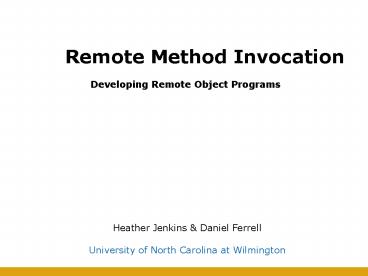Remote Method Invocation - PowerPoint PPT Presentation
1 / 16
Title:
Remote Method Invocation
Description:
is a framework for distributed objects using the Python programming language ... is a Java application programming interface for performing the object equivalent ... – PowerPoint PPT presentation
Number of Views:136
Avg rating:3.0/5.0
Title: Remote Method Invocation
1
Remote Method Invocation
Developing Remote Object Programs Hea
ther Jenkins Daniel Ferrell University of
North Carolina at Wilmington
2
Before Distributed Objects
- Began with monolithic mainframe systems
- Each system contained its own logic
- System was unable to share data with other
systems - Monolithic systems were inefficient and costly
- Reusing code was difficult
- Usually it meant copying a segment of code
- Modifying it
- Then deploying the modified copy
- A change to one meant a change to all
3
Distributed Objects
- Divides today's still monolithic client/server
applications into self-managing components, or
objects, which can interoperate across dissimilar
networks and operating systems. - EXAMPLE
- Programs that can be written which enable code on
other computers to send messages to them - oldUpdateProxy.adjust (oldVal, newVal)
4
Distributed Objects Applications
- CORBA
- lets one build distributed mixed object systems
- DCOM
- is a framework for distributed objects on the
Microsoft platform - PYRO
- is a framework for distributed objects using
the Python programming language - Distributed Ruby (DRb)
- is a framework for distributed objects using the
Ruby programming language - RMI
- is a Java application programming interface for
performing the object equivalent of remote
procedure calls.
5
RMI Remote Method Invocation
- Pure Java technology that is restricted to the
development of distributed objects expressed only
in Java - A mechanism that allows you to invoke a method or
an object that is located in another address
space - Provides a homogeneous environment
- It supports features such as code portability,
dynamic code loading, Java security, and garbage
collection
6
RMI Remote Method Invocation
- Registry
- The client communicates to the server and
requests an object. Once the registry has found
the object, then it directs the request to the
correct object. - Security
- INSECURE with RMI
- Spoofing someone acts as a client and could
potentially read data that the remote object has
access to. - Security Manager RMISecurityManage()
- Garbage Collectors
- Keeps a count of the number of references to
each object. When the number reaches 0, the
memory space is de-allocated for future use.
7
RMI Layer Terminology
- Stubs/Skeletons
- A stub for a remote object acts as a client's
local representative or proxy for the remote
object. - Remote Reference Layer
- determines whether the request is a Unicast or
Multicast Protocol. - Transport
- sets up and manages the request
8
Alternatives to RMI
- TCP Sockets
- implemented using TCP sockets to allow
distributed components of the system to
communicate with each other. - CORBA
- - Common Object Request Broker Architecture
More Expensive. No free development kit. Not
Java. - RCP Library
- Remote Procedure Call Better suited for linear
programming.
9
RMI Expensive? Cheap? Easy?
- Java is a widely known OOP
- - Development kits and other resources freely
available. - Cheaper than other alternatives of middleware
- - Cheaper than CORBA.
- JDK Development Kit 1.1
- - Development is can easily be started.
10
Implementation of RMI
- Remote Objects , Communication, Load Definitions
for Objects.
11
Example A Simple Hello World-
RemoteInterface.Java
- import java.rmi.Remote
- import java.rmi.RemoteException
- public interface RemoteInterface extends Remote
- String REGISTRY_NAME "RMI_Example"
- int REGISTRY_PORT 3273
- String getMessage() throws RemoteException
12
Server.Java
- import java.rmi.registry.LocateRegistry
- import java.rmi.registry.Registry
- import java.rmi.server.UnicastRemoteObject
- public class Server implements RemoteInterface
- public String getMessage()
- return "Hello World"
- public static void main(String args)
- try
- Registry registry
LocateRegistry.getRegistry(RemoteInterface.REGISTR
Y_PORT) - RemoteInterface remoteReference
- (RemoteInterface)
UnicastRemoteObject.exportObject(new Server()) - registry.rebind(RemoteInterface.REGIST
RY_NAME, remoteReference)
13
ClientApplet.Java
- import java.rmi.registry.LocateRegistry
- import java.rmi.registry.Registry
- import javax.swing.JApplet
- import javax.swing.JLabel
- public class ClientApplet extends JApplet
- public void init()
- try
- Registry registry
- LocateRegistry.getRegistry(getCode
Base().getHost(), RemoteInterface.REGISTRY_PORT) - RemoteInterface remoteReference
- (RemoteInterface)
registry.lookup(RemoteInterface.REGISTRY_NAME) - getContentPane().add(new
JLabel(remoteReference.getMessage())) - catch (Exception e)
14
How To Put It All Together
- 1. Create HTML File For Applet
- ltHTMLgt
- lttitlegtHello Worldlt/titlegt
- ltcentergt lth1gtHello Worldlt/h1gt lt/centergt
- The message from the HelloServer is
- ltpgt
- ltobject classid"javaClientApplet.class"
- type"application/x-java-applet"
- height"50" width"150" gt
- lt/objectgt
- lt/pgt
- lt/HTMLgt
15
Now Run!
- 1. Compile the classes.
- - javac .java
- Run RMI
- - rmic Server
- Start RMI Registry (Open Port)
- start rmiregistry 3273
- (unix) rmiregistry 3273
- Start the server
- start java Server
- (unix) java Server
- Open HTML!
16
RMI Questions?
- Questions?































